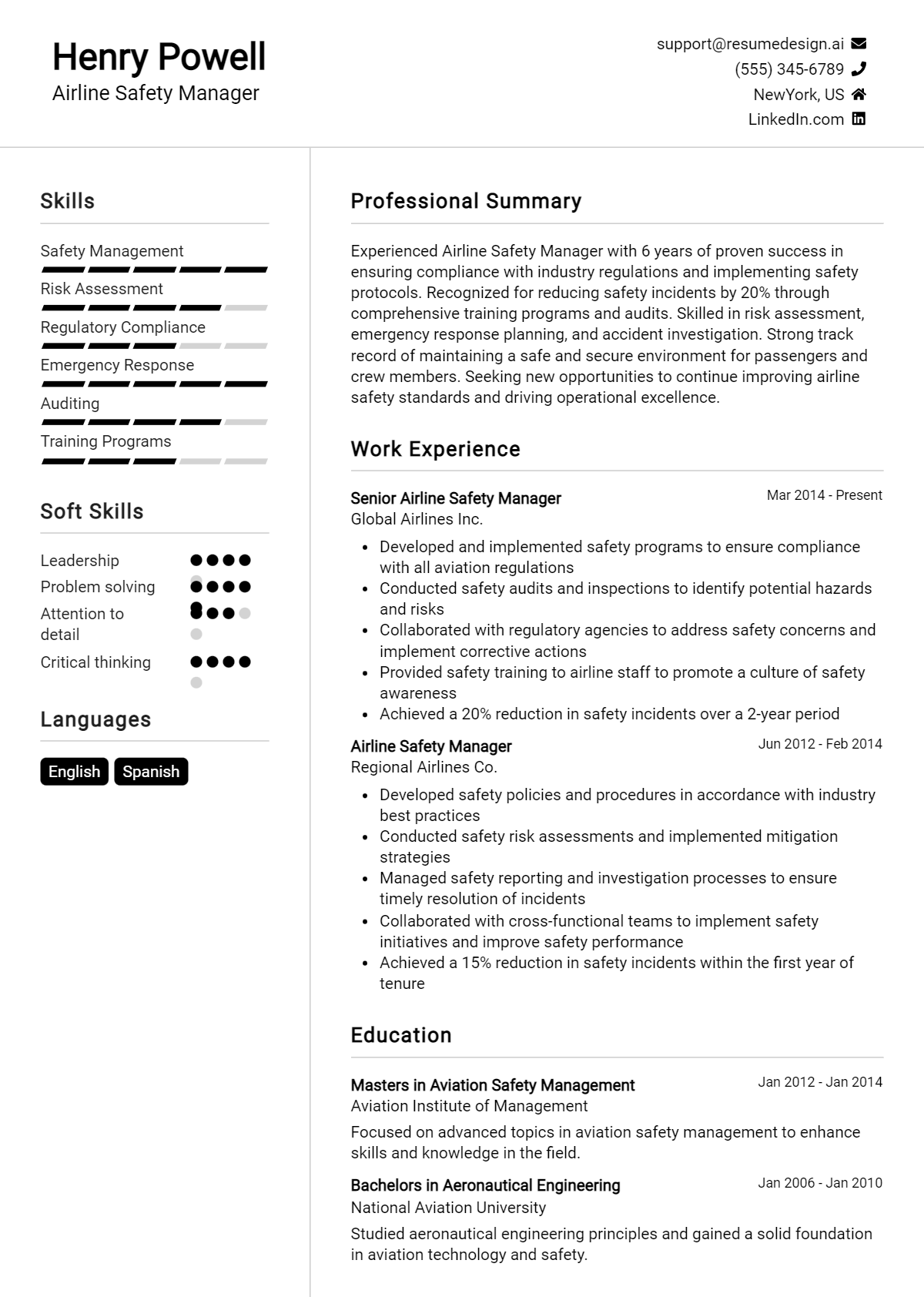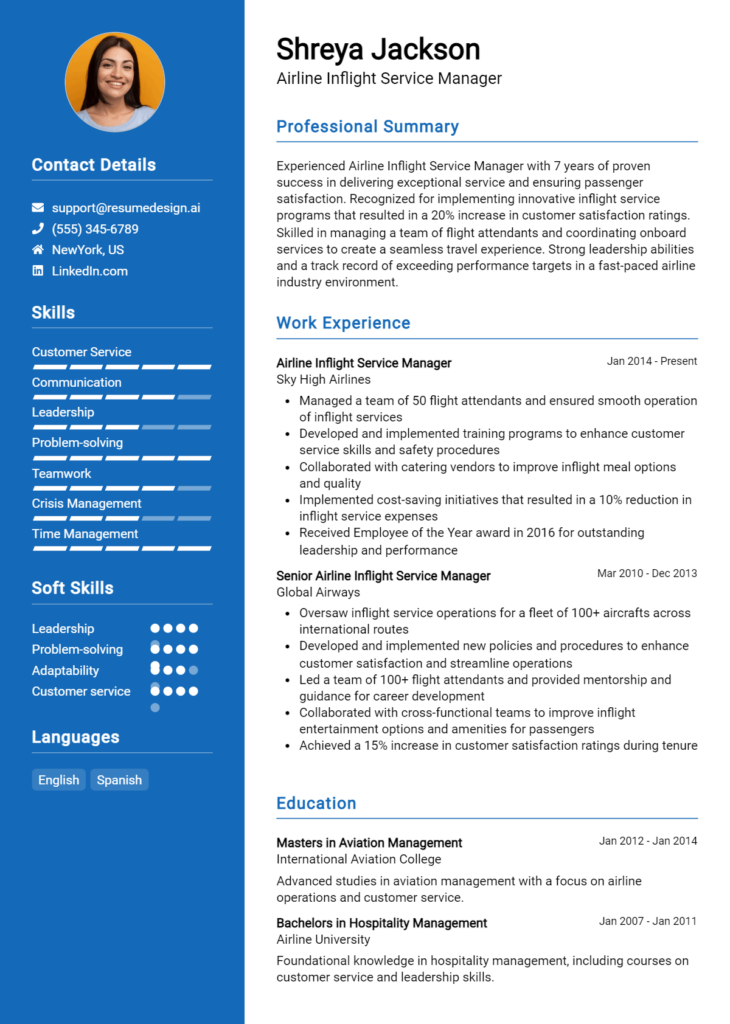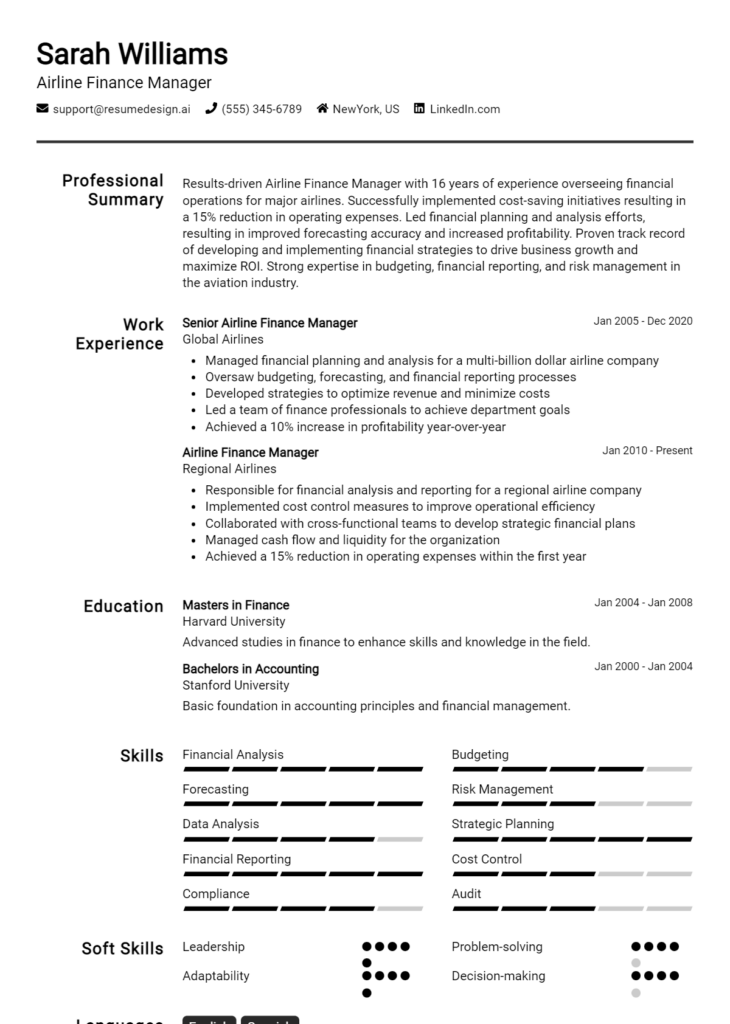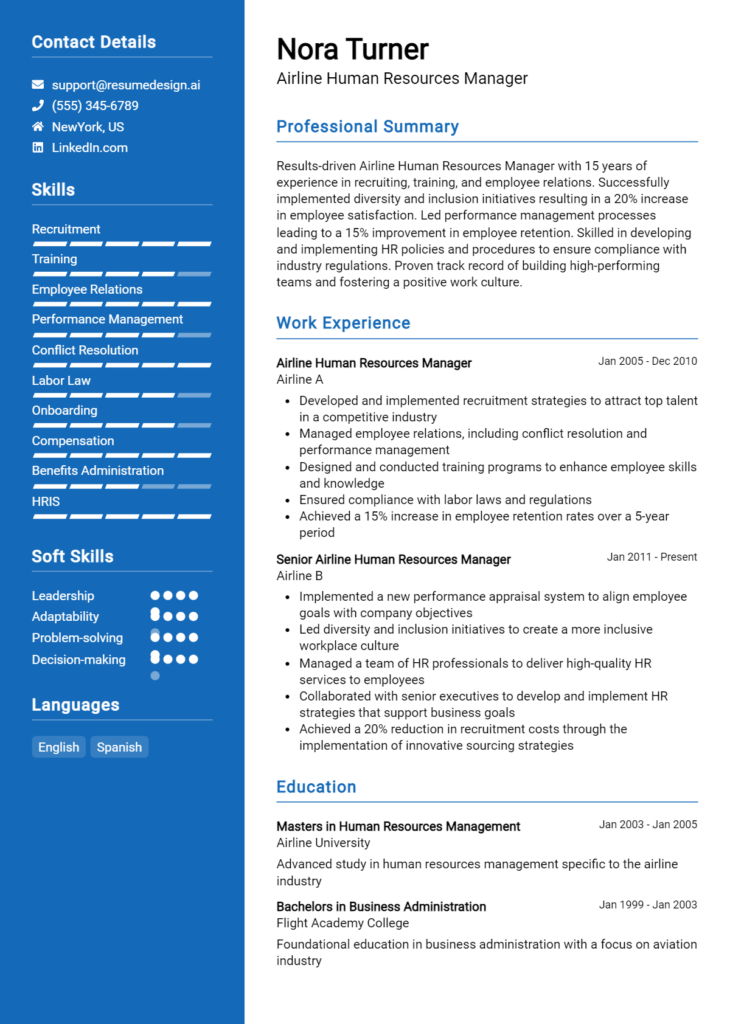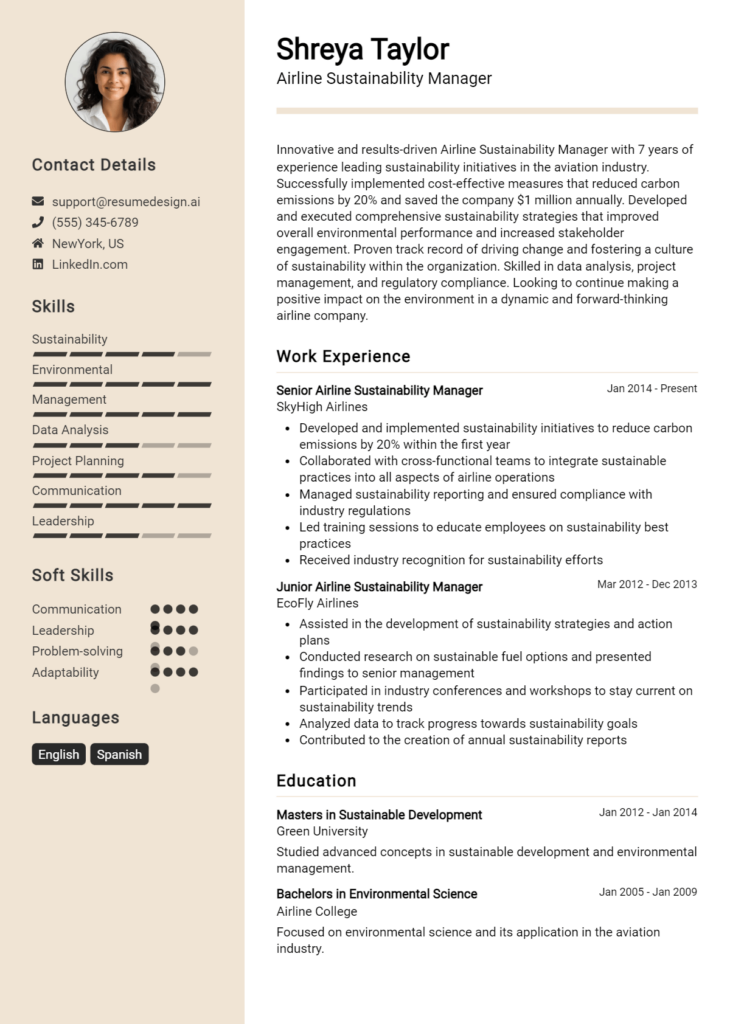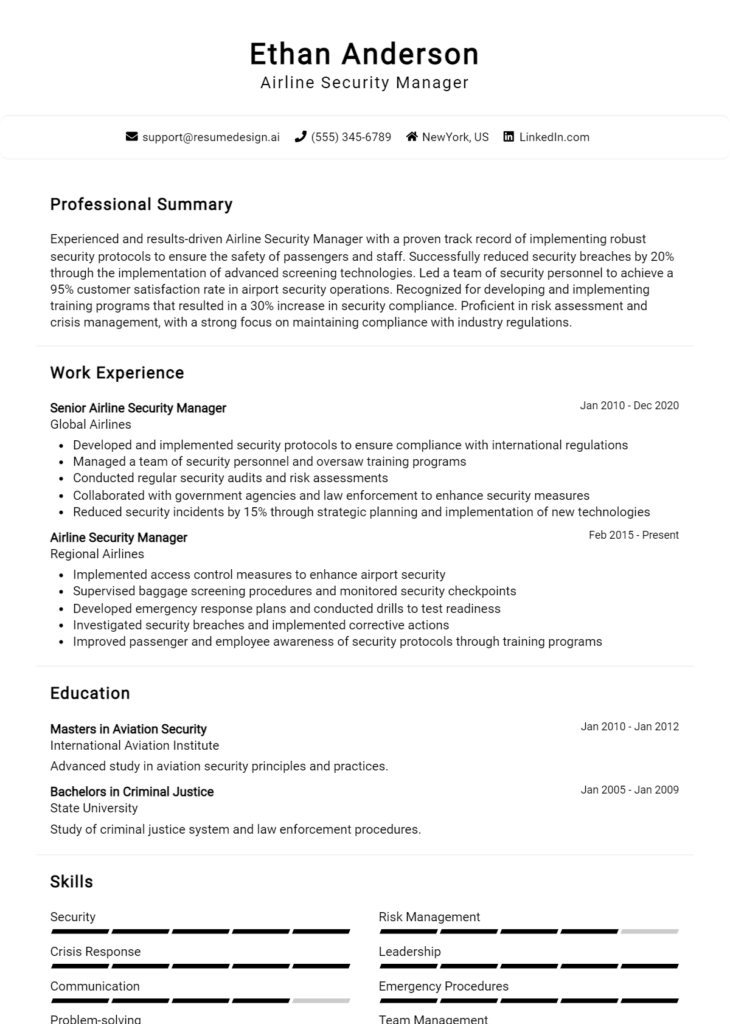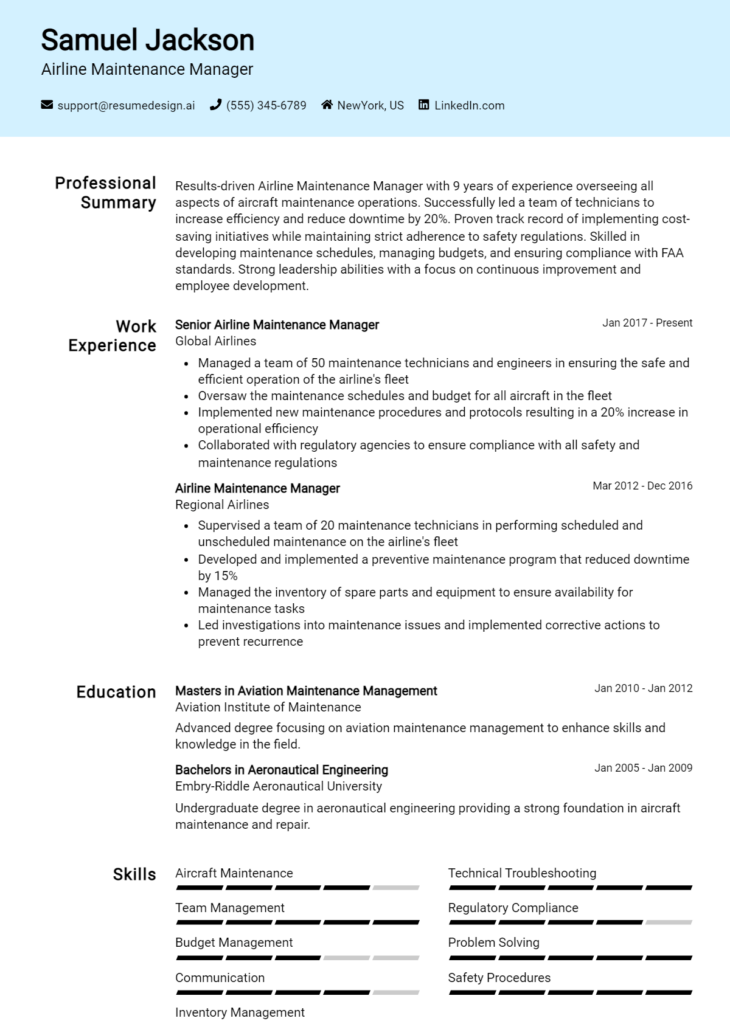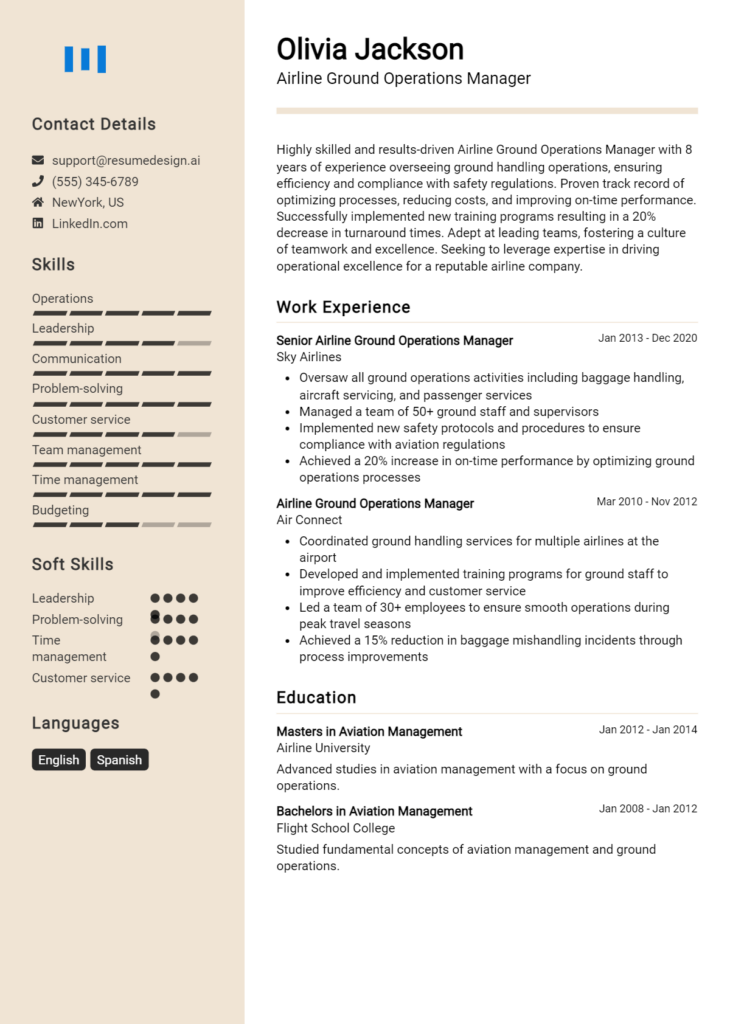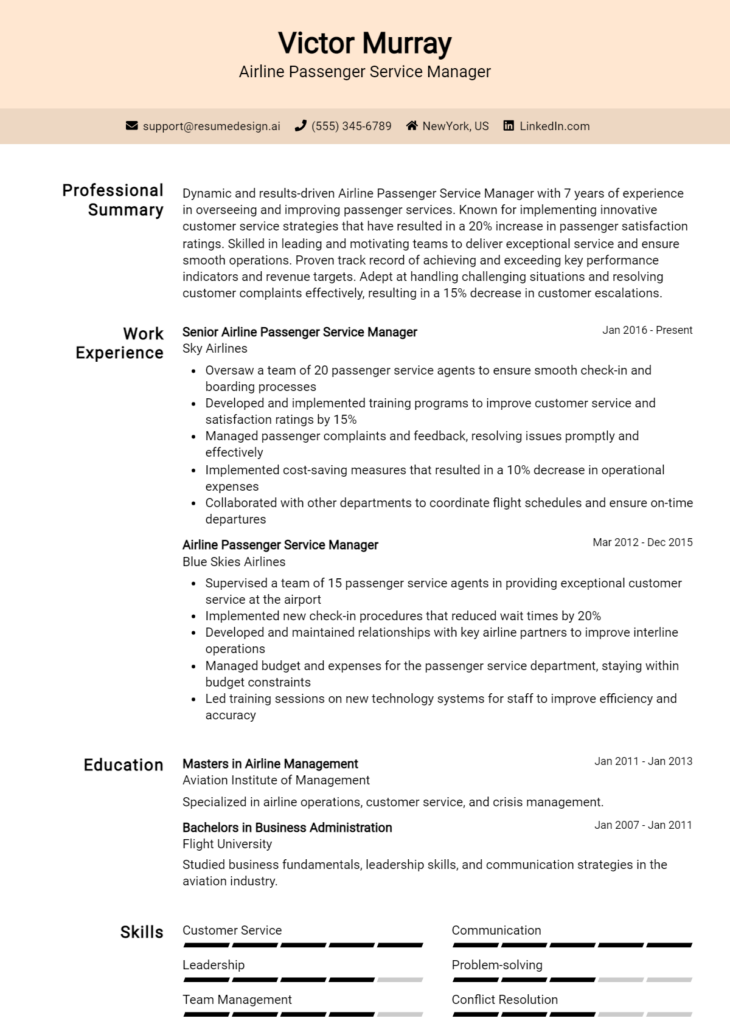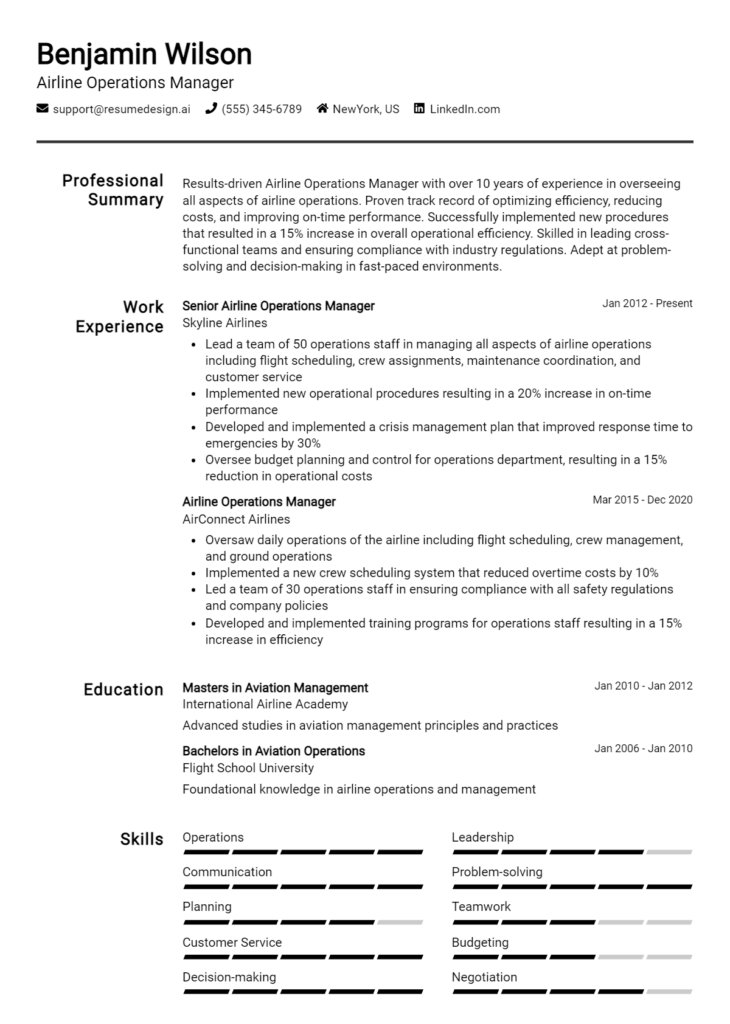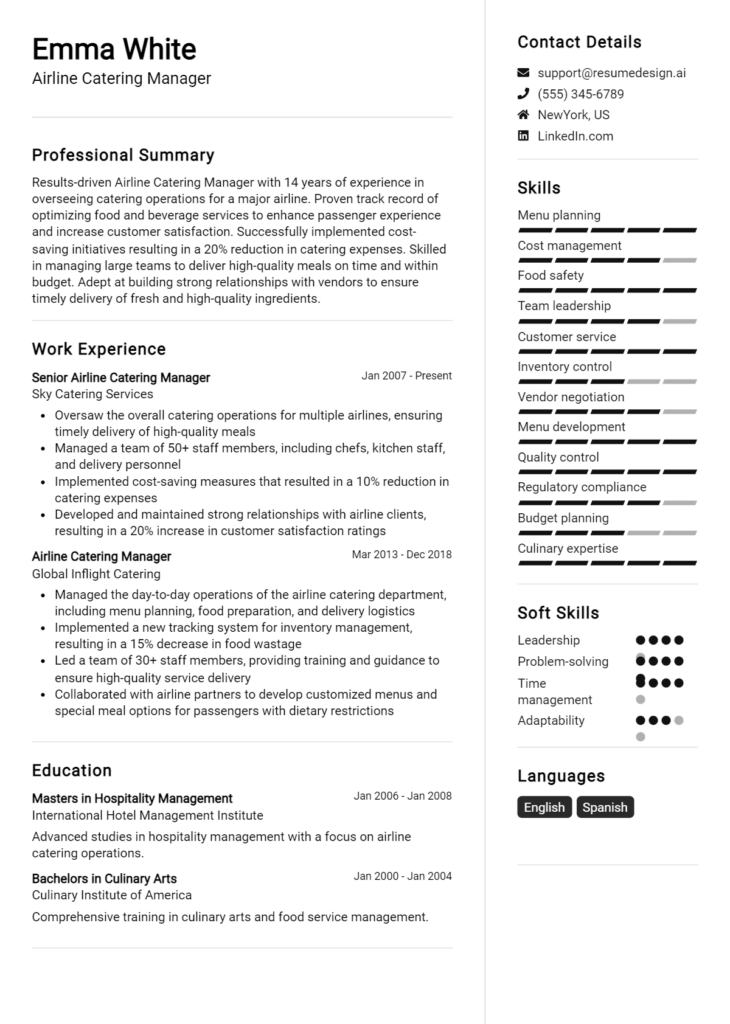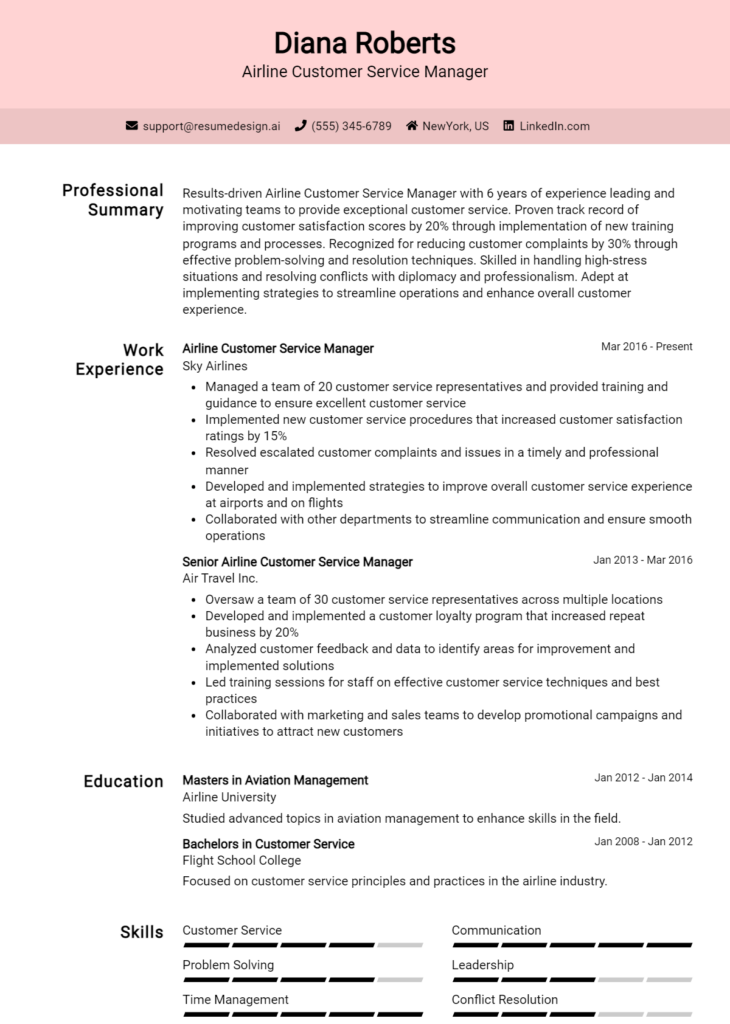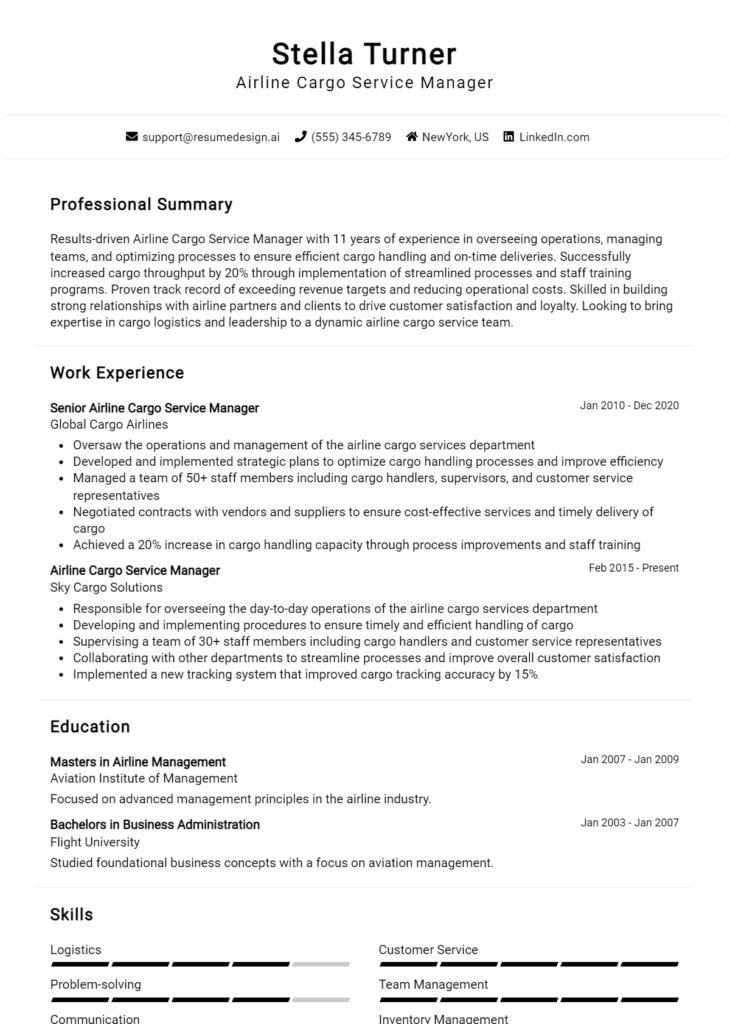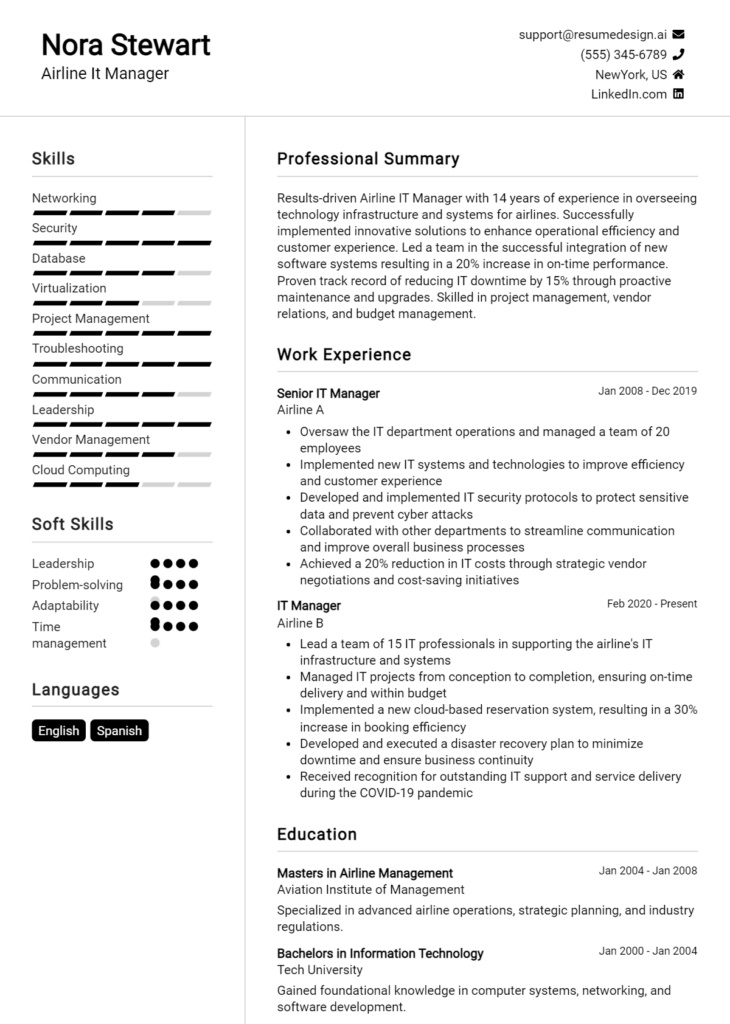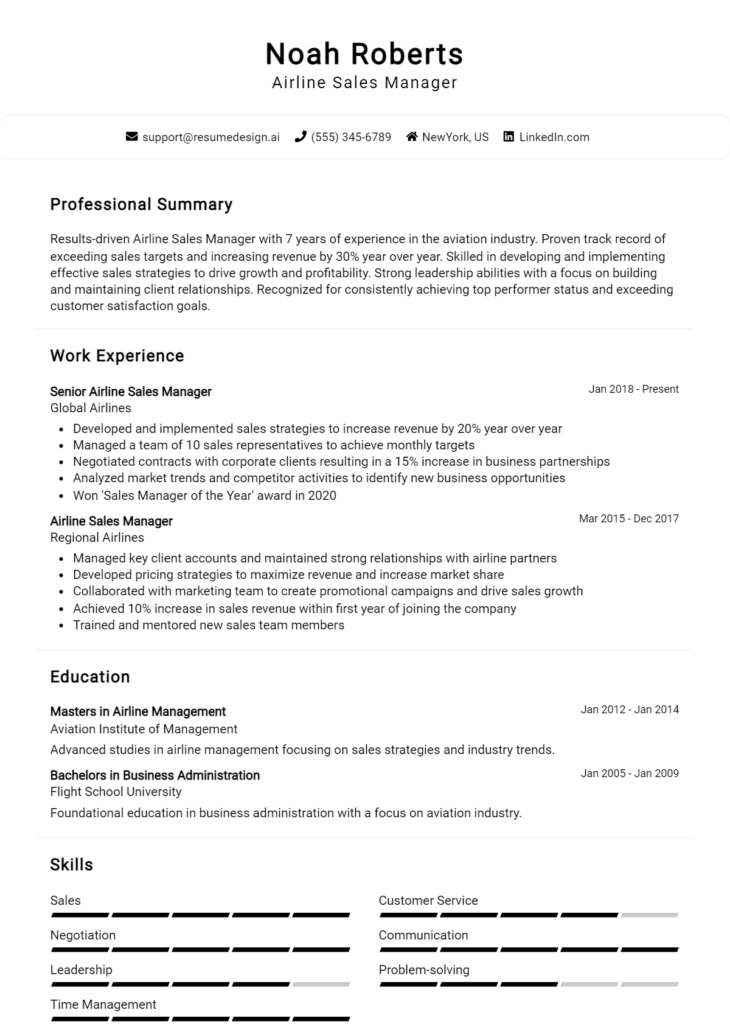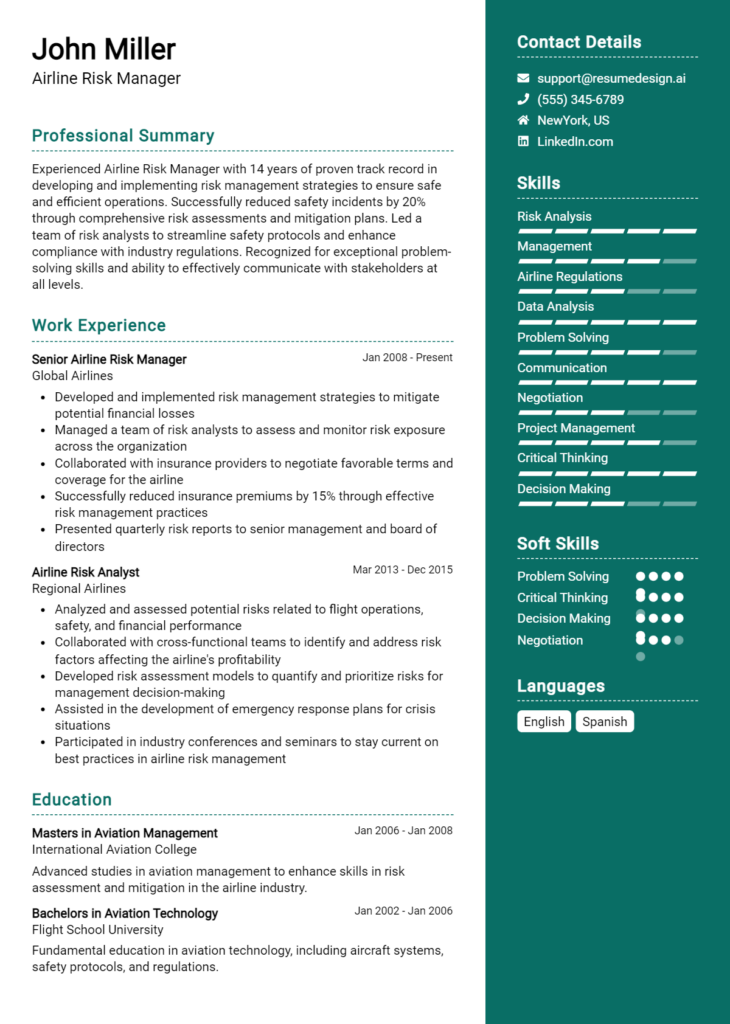Airline Safety Manager Core Responsibilities
An Airline Safety Manager plays a crucial role in ensuring the safety and compliance of airline operations. This professional collaborates across departments, such as operations, maintenance, and regulatory compliance, to implement safety protocols and enhance operational efficiency. Key skills include technical expertise in safety regulations, operational oversight, and strong problem-solving capabilities. These competencies are vital for achieving the organization's safety goals. A well-structured resume highlighting these qualifications can effectively demonstrate the candidate’s suitability for the role.
Common Responsibilities Listed on Airline Safety Manager Resume
- Develop and implement safety management systems and policies.
- Conduct regular safety audits and inspections.
- Analyze safety data and incident reports to identify trends.
- Collaborate with regulatory agencies to ensure compliance.
- Conduct safety training and awareness programs for staff.
- Lead incident investigation and reporting processes.
- Review and update emergency response plans.
- Monitor and evaluate safety performance metrics.
- Facilitate communication between departments regarding safety issues.
- Stay updated on industry safety regulations and best practices.
- Prepare safety reports for management and regulatory bodies.
High-Level Resume Tips for Airline Safety Manager Professionals
In the competitive field of aviation, an Airline Safety Manager's resume serves as the crucial first impression for potential employers. A well-crafted resume not only highlights essential skills and achievements but also conveys a candidate's commitment to safety and regulatory compliance. Given that safety is paramount in the airline industry, your resume must effectively demonstrate your proficiency and experience. This guide will provide practical and actionable resume tips specifically tailored for Airline Safety Manager professionals, helping you stand out in a crowded job market.
Top Resume Tips for Airline Safety Manager Professionals
- Tailor your resume to the job description by incorporating specific keywords and phrases that align with the role.
- Highlight relevant experience in safety management, including any positions held in aviation or related industries.
- Quantify your achievements, such as the percentage of safety incidents reduced or successful audits passed under your leadership.
- Showcase industry-specific skills, such as knowledge of FAA regulations, safety protocols, and risk assessment methodologies.
- Include certifications and training relevant to safety management, such as Safety Management Systems (SMS) or Aviation Safety Officer credentials.
- Utilize action verbs to convey your responsibilities and achievements clearly, making your impact more tangible.
- Ensure your resume is formatted for clarity and readability, using bullet points and headings to organize information effectively.
- Incorporate any experience with safety audits, inspections, or investigations, emphasizing your analytical and problem-solving skills.
- Provide references or endorsements from previous employers or colleagues who can vouch for your expertise in safety management.
By implementing these tips, you can significantly enhance your resume's effectiveness, ultimately increasing your chances of securing a position in the Airline Safety Manager field. A polished, targeted resume will not only showcase your qualifications but also reflect your dedication to maintaining the highest safety standards in aviation.
Why Resume Headlines & Titles are Important for Airline Safety Manager
In the competitive field of aviation, the role of an Airline Safety Manager is paramount to ensuring the highest standards of safety and compliance. A well-crafted resume headline or title serves as a crucial first impression for hiring managers, succinctly summarizing a candidate's key qualifications and expertise. A strong headline can immediately grab attention, offering a compelling snapshot of what the candidate brings to the table. It should be concise, relevant, and directly aligned with the specific job being applied for, making it easier for hiring professionals to recognize the candidate's potential fit for the role.
Best Practices for Crafting Resume Headlines for Airline Safety Manager
- Keep it concise: Aim for 6-10 words that convey your main qualifications.
- Be role-specific: Incorporate keywords related to the Airline Safety Manager position.
- Highlight key achievements: Mention notable certifications, accomplishments, or experiences.
- Use action-oriented language: Start with strong verbs to convey proactivity and leadership.
- Incorporate metrics: Where applicable, include quantifiable results to showcase impact.
- Avoid generic terms: Steer clear of clichés or vague phrases that dilute your message.
- Tailor to the job description: Customize your headline to reflect the specific requirements of the position.
- Make it visually appealing: Use formatting that stands out but remains professional.
Example Resume Headlines for Airline Safety Manager
Strong Resume Headlines
Experienced Airline Safety Manager with 10+ Years in Regulatory Compliance
Certified Safety Professional Specializing in Aviation Risk Management
Proven Track Record of Enhancing Safety Protocols and Reducing Incident Rates
Dynamic Leader in Airline Safety with Expertise in Crisis Management
Weak Resume Headlines
Manager Looking for a Job
Safety Professional with Experience
The strong headlines are effective because they convey specific skills, experiences, and accomplishments that directly relate to the role of an Airline Safety Manager. They use clear, action-oriented language, making it easy for hiring managers to recognize the candidate's value. In contrast, the weak headlines fail to make an impact; they are vague, lack specificity, and do not communicate any unique qualifications or achievements, ultimately leaving hiring professionals uninterested and uninspired to learn more about the candidate.
Writing an Exceptional Airline Safety Manager Resume Summary
A resume summary is a critical component for an Airline Safety Manager's application, as it serves as a brief overview of the candidate's qualifications and sets the tone for the entire resume. In a field where safety is paramount, hiring managers often look for quick insights into a candidate's relevant experience, key skills, and notable accomplishments. A well-crafted summary not only captures attention but also highlights the applicant's suitability for the role. To maximize impact, the summary should be concise, engaging, and tailored to reflect the specific requirements of the job being applied for.
Best Practices for Writing a Airline Safety Manager Resume Summary
- Quantify achievements: Use specific numbers or percentages to demonstrate the impact of your work.
- Focus on relevant skills: Highlight the skills that are directly applicable to airline safety management.
- Tailor the summary: Customize your summary to align with the job description and company values.
- Keep it concise: Aim for 3-5 sentences that deliver a compelling message without unnecessary detail.
- Use action verbs: Start sentences with strong action verbs to convey a sense of proactivity and effectiveness.
- Showcase certifications: Mention relevant certifications or training that enhance your qualifications.
- Highlight leadership experience: Emphasize any supervisory or leadership roles that demonstrate your ability to manage teams effectively.
- Incorporate safety metrics: Reference safety metrics or compliance standards you have successfully met or exceeded.
Example Airline Safety Manager Resume Summaries
Strong Resume Summaries
Dynamic Airline Safety Manager with over 10 years of experience in aviation safety compliance, achieving a 30% reduction in incidents through proactive risk assessments and training programs. Proven track record of leading safety audits and implementing industry best practices.
Results-driven professional with extensive expertise in safety management systems, enhancing operational efficiency by 25% in the past year. Certified Safety Professional (CSP) with a strong background in regulatory compliance and employee training initiatives.
Accomplished Airline Safety Manager recognized for developing and executing safety protocols that improved incident reporting accuracy by 40%. Skilled in cross-functional team leadership and regulatory negotiations, ensuring adherence to FAA guidelines.
Weak Resume Summaries
Experienced Safety Manager looking for a new opportunity in the airline industry. I have a strong background in safety.
Airline Safety expert with many years of experience. I am dedicated to improving safety standards in aviation.
The strong resume summaries effectively convey specific achievements, relevant skills, and quantifiable results that demonstrate the candidate's effectiveness in the role. They are tailored to the position and emphasize the candidate's ability to enhance safety practices within an airline. In contrast, the weak summaries lack detail and specificity, making them less compelling and failing to differentiate the candidates from others in the field. They do not provide measurable outcomes or pertinent information that would capture the hiring manager's attention.
Work Experience Section for Airline Safety Manager Resume
The work experience section of an Airline Safety Manager resume is a critical component that provides potential employers with insights into a candidate's professional background, technical skills, and leadership capabilities. This section not only highlights the candidate's relevant experience but also demonstrates their ability to manage teams effectively and deliver high-quality safety outcomes in line with industry standards. By quantifying achievements and aligning experiences with best practices in aviation safety, candidates can significantly enhance their appeal to hiring managers, showcasing their readiness to contribute to a safe and efficient airline operation.
Best Practices for Airline Safety Manager Work Experience
- Emphasize relevant safety certifications and technical expertise related to aviation safety management systems.
- Quantify achievements with specific metrics, such as reductions in incident rates or improvements in compliance audits.
- Highlight experience in leading safety teams and cross-functional collaboration to ensure comprehensive safety protocols.
- Use action verbs to convey leadership and initiative in developing safety programs and training sessions.
- Align experiences with industry standards and regulatory requirements to demonstrate compliance knowledge.
- Detail specific projects that resulted in tangible improvements in safety processes or procedures.
- Showcase experience in conducting safety audits and risk assessments, detailing outcomes and recommendations.
- Include contributions to safety culture initiatives that foster employee engagement and awareness.
Example Work Experiences for Airline Safety Manager
Strong Experiences
- Led a team of 10 safety officers in a comprehensive safety audit program, resulting in a 25% reduction in reportable incidents over two years.
- Developed and implemented a new safety training program that improved employee compliance rates by 40%, contributing to enhanced operational safety.
- Collaborated with cross-functional teams to redesign emergency response protocols, resulting in a 30% faster response time during drills and increased readiness.
- Managed the integration of a new safety management system that streamlined reporting processes, reducing documentation errors by 50%.
Weak Experiences
- Worked on safety programs without specifying the impact or improvements achieved.
- Assisted in safety audits but did not detail personal contributions or outcomes.
- Participated in team meetings related to safety issues without clarifying role or results.
- Involved in safety training sessions but failed to mention any measurable improvements in employee performance.
The examples of strong experiences are characterized by clear, quantifiable outcomes and specific roles in teamwork and leadership, showcasing the candidate's direct impact on airline safety. In contrast, the weak experiences lack detail and fail to communicate the candidate's contributions, making it difficult for potential employers to gauge their effectiveness and suitability for the role. Strong experiences provide a compelling narrative of achievement, while weak experiences leave significant gaps in understanding the candidate's capabilities.
Education and Certifications Section for Airline Safety Manager Resume
The education and certifications section of an Airline Safety Manager resume is crucial for showcasing a candidate's academic background and relevant qualifications. This section highlights not only formal degrees but also industry-recognized certifications and specialized training that reflect the candidate's commitment to continuous learning and professional development. By providing details about relevant coursework, certifications, and specialized training, candidates can significantly enhance their credibility and demonstrate their alignment with the specific requirements of the Airline Safety Manager role, making them stand out in a competitive job market.
Best Practices for Airline Safety Manager Education and Certifications
- Include only relevant degrees and certifications that pertain to aviation safety or management.
- List advanced degrees, such as a Master's in Aviation Safety or Management, to highlight your educational background.
- Incorporate industry-recognized certifications such as Certified Aviation Manager (CAM) or Safety Management Systems (SMS) certifications.
- Detail specialized training programs or workshops that enhance your skills in risk assessment and safety protocols.
- Provide the dates of completion for certifications to illustrate your commitment to staying current in the field.
- Highlight any continuing education courses that demonstrate your proactive approach to professional development.
- Use clear and concise language to convey your qualifications, avoiding jargon that may confuse hiring managers.
- Organize the section in reverse chronological order, starting with the most recent accomplishments to emphasize ongoing learning.
Example Education and Certifications for Airline Safety Manager
Strong Examples
- M.S. in Aviation Safety Management, Embry-Riddle Aeronautical University, 2022
- Certified Aviation Manager (CAM), National Business Aviation Association, 2021
- Safety Management Systems (SMS) Certification, International Civil Aviation Organization, 2020
- Coursework in Human Factors in Aviation Safety, University of Southern California, 2019
Weak Examples
- B.A. in History, University of XYZ, 2005
- CPR Certification, Red Cross, 2018
- Online Course in Basic First Aid, 2017
- Certification in Microsoft Office Suite, 2016
The strong examples are considered effective because they are directly relevant to the role of an Airline Safety Manager, demonstrating advanced knowledge and specialized skills necessary for ensuring safety in aviation. In contrast, the weak examples lack direct application to the aviation industry, showcasing outdated qualifications and non-industry-specific certifications that do not enhance the candidate's profile for this specific job role.
Top Skills & Keywords for Airline Safety Manager Resume
As an Airline Safety Manager, the importance of showcasing relevant skills on your resume cannot be overstated. This role is critical in ensuring the safety and well-being of passengers, crew members, and aircraft operations. A well-crafted resume that highlights both hard and soft skills can set you apart from other candidates, demonstrating your capability to manage safety protocols, respond to emergencies, and foster a culture of safety within the organization. By effectively communicating your qualifications through targeted skills, you enhance your chances of landing interviews and securing a position that plays a vital role in the aviation industry.
Top Hard & Soft Skills for Airline Safety Manager
Soft Skills
- Attention to Detail
- Strong Communication
- Leadership Ability
- Problem-Solving Skills
- Team Collaboration
- Decision-Making
- Adaptability
- Conflict Resolution
- Critical Thinking
- Organizational Skills
- Interpersonal Skills
- Stress Management
- Empathy
- Time Management
- Negotiation Skills
Hard Skills
- Risk Assessment and Management
- Aviation Regulations Knowledge
- Safety Management Systems (SMS)
- Incident Investigation Techniques
- Emergency Response Planning
- Data Analysis and Reporting
- Safety Audits and Inspections
- Regulatory Compliance
- Training and Development Programs
- Aviation Safety Certifications (e.g., FAA, ICAO)
- Quality Assurance Processes
- Technical Proficiency in Safety Software
- Aircraft Operations Knowledge
- Environmental Health and Safety (EHS) Standards
- Incident Reporting Systems
For further insights into how to effectively present your skills and work experience on your resume, consider exploring additional resources that can enhance your application.
Stand Out with a Winning Airline Safety Manager Cover Letter
Dear Hiring Manager,
I am writing to express my interest in the Airline Safety Manager position at [Airline Name], as advertised on [Job Platform]. With over [X years] of experience in aviation safety management, I have developed a comprehensive understanding of safety regulations, risk management, and operational protocols that ensure compliance and promote a culture of safety within an organization. My background, coupled with a proven track record of implementing effective safety programs, makes me a strong candidate for this role.
In my previous position at [Previous Airline/Company Name], I successfully led a team that conducted safety audits, developed training programs, and established safety performance metrics. One of my key achievements was the reduction of incident rates by [X%] through the implementation of a proactive safety management system. I am well-versed in industry standards such as FAA regulations and ICAO guidelines, and I am committed to fostering an environment where safety is prioritized at every level of operation. My collaborative approach allows me to work effectively with diverse teams, ensuring that safety measures are understood and adhered to by all employees.
I am particularly drawn to the opportunity at [Airline Name] because of your commitment to excellence in safety and innovation in the aviation industry. I am eager to bring my expertise in safety management and my passion for aviation to your esteemed organization. I am confident that my proactive mindset and strong analytical skills will contribute to enhancing safety protocols and ensuring compliance with regulatory requirements.
Thank you for considering my application. I look forward to the opportunity to discuss how my background and vision align with the goals of [Airline Name]. I am excited about the possibility of contributing to your team and helping to maintain the highest standards of safety in your operations.
Sincerely,
[Your Name]
[Your Phone Number]
[Your Email Address]
Common Mistakes to Avoid in a Airline Safety Manager Resume
When crafting a resume for the role of an Airline Safety Manager, it's crucial to present your qualifications and experience in a way that highlights your expertise and aligns with industry standards. However, many candidates make common mistakes that can hinder their chances of landing an interview. By avoiding these pitfalls, you can create a compelling resume that showcases your skills and dedication to maintaining safety in aviation.
Neglecting Industry-Specific Terminology: Failing to use relevant jargon can make your resume less impactful. Incorporate terms like "Safety Management Systems (SMS)" and "Regulatory Compliance" to demonstrate your familiarity with the field.
Including Irrelevant Experience: Listing unrelated job experiences can dilute your focus. Tailor your resume to highlight positions and responsibilities that directly relate to safety management in aviation.
Using Generic Job Descriptions: Avoid vague descriptions of your previous roles. Instead, provide specific examples of your achievements and contributions to safety initiatives, which can set you apart from other candidates.
Omitting Quantifiable Achievements: Employers appreciate measurable outcomes. Include data-driven results, such as reductions in incident rates or improvements in safety audits, to demonstrate your effectiveness.
Neglecting Soft Skills: While technical skills are vital, soft skills like communication, leadership, and problem-solving are equally important in safety management. Highlighting these traits can illustrate your capability to lead and influence a safety culture.
Poor Formatting and Design: A cluttered or unprofessional layout can distract from your qualifications. Use clear headings, bullet points, and consistent formatting to enhance readability.
Ignoring Relevant Certifications: Failing to mention certifications, such as Safety Management System (SMS) training or OSHA credentials, can weaken your resume. Ensure these are prominently displayed to emphasize your qualifications.
Not Tailoring the Resume for Each Application: Sending a generic resume can be detrimental. Customize your resume for each job application by aligning your qualifications with the specific requirements of the position you are applying for.
Conclusion
As an Airline Safety Manager, your primary responsibility is to ensure the safety and compliance of airline operations. This role requires a deep understanding of aviation regulations, risk management, and safety protocols. Key points to consider include:
Regulatory Knowledge: Familiarize yourself with the latest aviation safety regulations, including those set forth by the FAA and other governing bodies.
Risk Assessment: Develop and implement risk management strategies to identify potential safety hazards and mitigate them effectively.
Training and Development: Ensure that all staff members are adequately trained in safety procedures and protocols, promoting a culture of safety within the organization.
Incident Investigation: Lead investigations into safety incidents and accidents, analyzing data to prevent future occurrences.
Communication Skills: Foster open communication channels among team members and stakeholders to ensure safety concerns are promptly addressed.
In conclusion, attention to detail and a proactive approach to safety are essential qualities for an Airline Safety Manager. As you reflect on your qualifications and experiences, it’s crucial to ensure that your resume effectively showcases your skills and accomplishments in this vital role.
Take action today! Review your Airline Safety Manager resume to make sure it highlights your expertise. Utilize available resources such as resume templates, a resume builder, and resume examples to create a polished document. Don’t forget to enhance your application with a compelling cover letter template that aligns with your professional narrative. Start crafting your path to success now!

